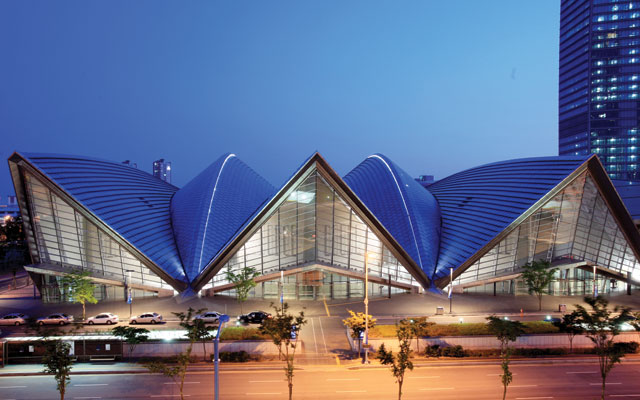Secondary destinations Daejeon, Gunsan and Songdo City, with their niche industries, are being enhanced and thrusted in the MICE limelight
Build it, and they will come – seems to be the motto of South Korea when it comes to business events.
Keen to leverage its vibrant knowledge industries to grab hold of even more association business, South Korea has encouraged a boom in convention centre construction and expansion in its cities with niche specialties in certain fields.

Minhong Min, executive director of the Korea MICE Bureau, said: “South Korea hosted 635 international conventions and meetings in 2013, according to the UIA report.”
An ICCA ranking also found the country to have welcomed 260 international association meetings, the 12th largest number of such events in a single country in 2013, he added. “By any report, we are jumping up.”
Asked what set South Korea apart from other meeting destinations, he said the “number one” factor is the Korean pop culture wave sweeping across Asia, Europe and even the Middle East, the “increasing attention and curiosity towards Korea”.
He continued: “Second, we have many newly developed infrastructure. Ten years ago we only had four convention centres. Now we have 14. Regional cities compete with each other to host international events, resulting in a higher level of service. We spent US$20 million in the MICE industry last year.
“All our industries are seeing upward growth, especially the medical sectors and medical association congresses.
“Our policy is to focus (on promoting destinations) outside Seoul, so we provide incentives for other destinations.Seoul is an Asian hub, but to extend stays in (South) Korea, we are promoting other destinations like Jeju and Busan, both also popular for MICE.”
The bureau also thrusted lesser-known destinations Daejeon, Gunsan, and Incheon’s Songdo City in the spotlight during a recent MICE media fam trip. All three are beneficiaries of a determination to add more space and facilities for business events and association businesses.
Daejeon for one, besides being a major transport hub for its location in the heart of South Korea, is a brain bank for the country with its host of research institutions, technology companies and universities, as well as medical tourism focus.
The Daejeon Convention Center (DCC) opened in 2008, is focused on conferences but has a Grand Ballroom for 2,000 pax, a 2,520m2 multifunctional hall, and 17 mid- and small-sized meeting rooms, making it suitable for congresses.
Angeline Park, manager, convention marketing team, Convention & Visitors Bureau Daejeon, Daejeon International Marketing Enterprise, which is an affiliate of the city government and runs the convention centre, said over 600 conferences and exhibitions are held at the venue a year, including domestic events.
Some events to be hosted by DCC include the 2015 Pacific and Asian Society of Minimally Invasive Spinal Surgery, and 2020 International Union of Microbiological Societies Congress.
Park revealed: “We are building an entertainment and F&B complex, to be opened in 2018/2019.” This 12,500m2 complex will replace the existing DIME Exhibition Hall adjacent to DCC.
On the other hand, Gunsan city in North Jeolla was a big port city 50-60 years ago, and now has the largest industrial complexes in South Korea, with car production and sustainable energy being two key industries.
The Gunsan Saemangeum Convention Center (GSCO) was launched last July, and has since hosted tradeshows related mostly to heavy machinery and cars.
It is the latest addition to the 3,697m2 exhibition hall that opened in 2004, and an annex building that began operations in 2007. Renovations of the annex building will commence in August, to add nine rooms for up to 250 pax each.
Rental rates for exhibition hall and meeting rooms are 30 and 50 per cent lower than other cities, respectively, said Trudy Baek, MICE business team assistant manager, GSCO.
Asked what prompted the decision to build the facility, Baek said: “Gunsan has a good logistics system…All regional governments (in South Korea) are very interested in MICE.”
Meanwhile, a bright spark on Incheon’s horizon is ‘smart city’ Songdo, home to some 450 MNCs, and the G-Tower where the UN has housed a good number of its offices.
Maureen Kim, director of Incheon Convention Visitors Bureau, said: “Songdo is good for international businesses and organisations as it is close to both Japan and China, and we have set up a team to host such events. Our plan is to attract organisations to set up (HQ) in the city and then have them invite their counterparts to hold meetings here.
“Since 2008, we have targetted getting more UN meetings in the city. By end-2013, we had hosted the Green Climate Fund organisation HQ meeting, the Association of World Election Bodies, and World Bank events.”
Kim said having dealt with large-scale events is an advantage when attracting association business, and the presence of UN organisations and meetings in Incheon is a key differentiation point.
Songdo’s main large-scale venue is Songdo Convensia Convention Center, opened in 2008. Plans are underway to double the centre’s space within the next three years. Some events to be held at the centre this year include the International Symposium Anti-microbial Agents and Resistence; KALAS International Symposium; World Congress on Advances in Aeronautics, Nano, Bio Robotics and Energy; and 20th Meeting of the Scientific Committee.
Meanwhile, Glynn Cho, secretary general of the newly formed Korea Society of Association Executives (KSAE), said although the MICE industry has “developed dramatically” in the last decade, there is still a need for Korean associations to get actively involved in global events to invite more international meetings.
“Also, I think we have to improve the quality of events to match those in Western countries,” he added.
KSAE benchmarks itself against the American Society of Association Executives and aims to advance the skills of local industry practitioners through education, training, networking and advocacies.
Cho cited the unstable political climate especially between North and South Korea, the lacklustre global economic climate, shortage of specialists in huge events for small- and medium-sized associations, poor language skills, as well as a lack of brand-name international events by Korean organisers as some obstacles to bringing in more association meetings to the country.
“KSAE will improve the situation through active campaigns and education. The government has a lot of good initiatives to bring in global associations events, but we have to strengthen the basic activities of associations in the global market systematically, through the AMC, DMC and PCO/PEO, so we can approach decision makers easily and use the chance to nominate South Korea as a venue for their events.”











